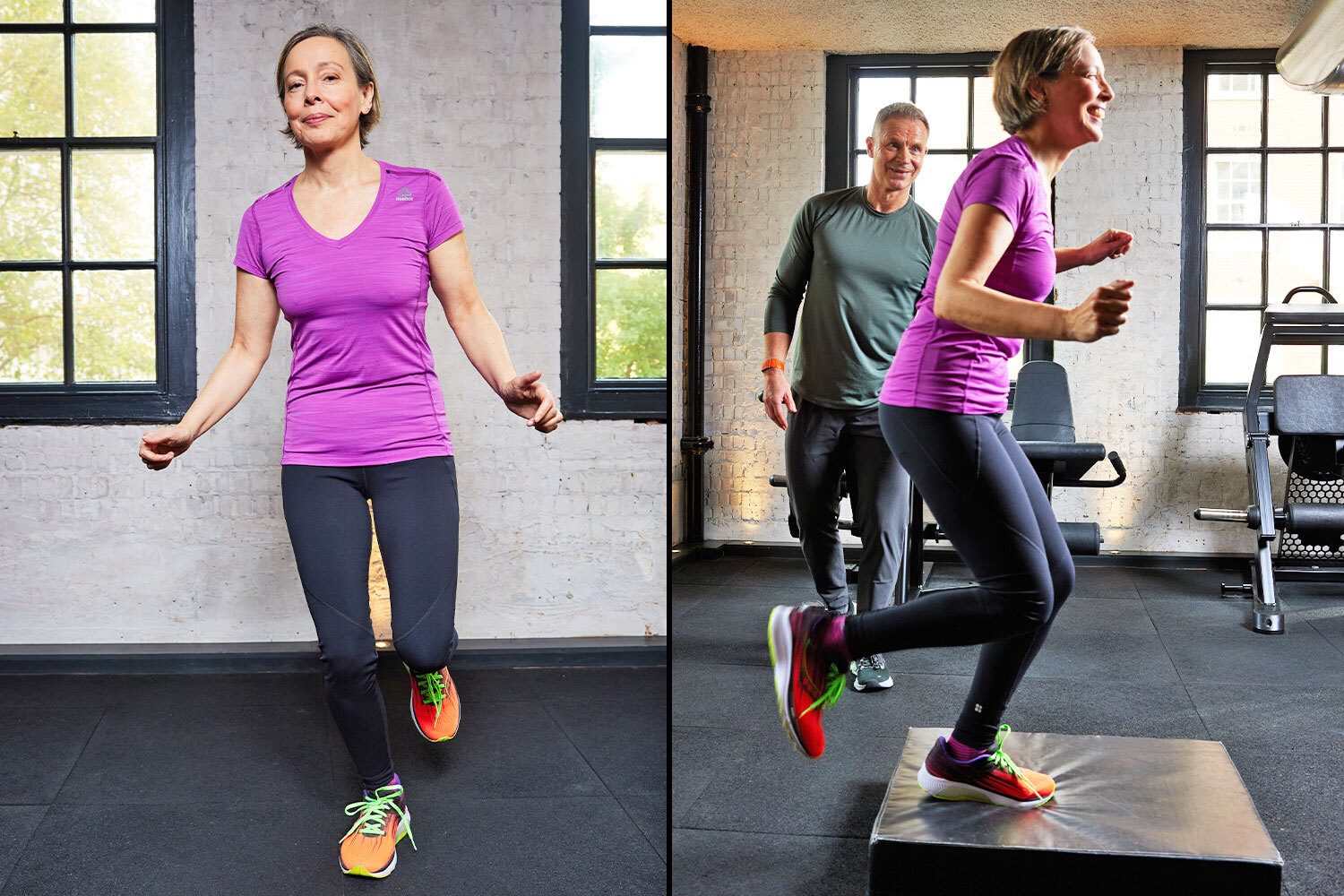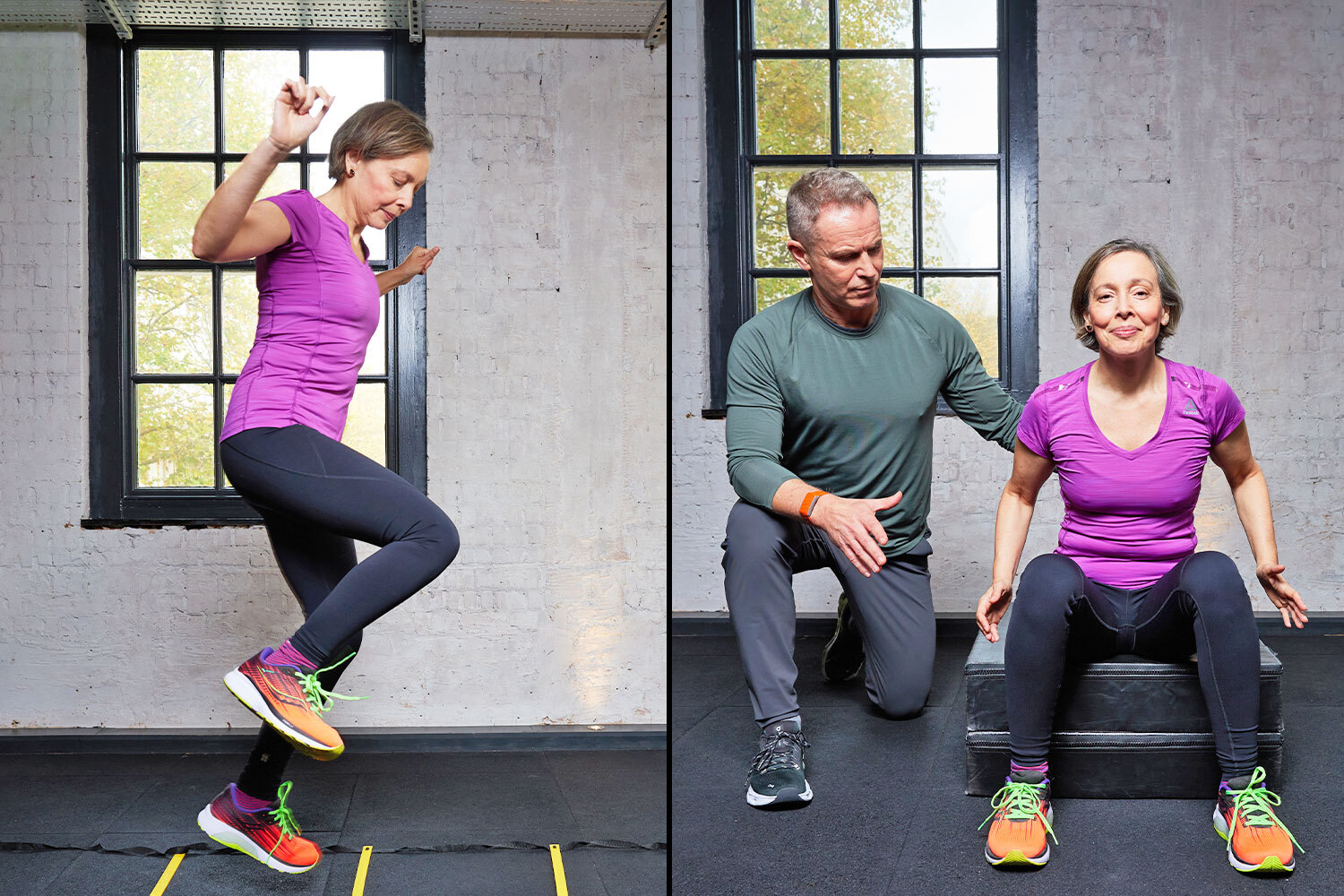Who dares jump in midlife? Me, although I did take a 45-year break from it. I last loved leaping aged six, skipping in the playground to the chant of: “Mother’s in the kitchen doing her stitching!” By ten, though, jumping for joy had been ruined by high jump in PE, which entailed hurling myself desperately over a metal bar set at neck level and running into it. In adulthood my back ached so I stuck to controlled, low-impact workouts: swimming, Pilates. I quit treadmill jogs at 40 and rarely troubled a gym machine.
Then last year, after a bone mineral density (BMD) scan at Matt Roberts’s health club Evolution, I discovered I was crumbling away on the inside. The BMD of my spine was 0.746g/cm² and my T-score was minus 2.7. If you’re over 40 and your T-score is less than minus 2.5, you have osteoporosis.
• I’m 55, eat well, don’t smoke and exercise. Yet I have osteoporosis
Highly displeased, I committed to Evolution’s bone strength programme, which as I expected involved kick-arse weight training. But when, weeks in, my personal trainer asked me to jump — forwards, as far as I could — I was aghast. What? No. Why? Ugh. It felt alien and wrong. He explained that studies show 10 to 20 jumps daily can increase bone mass and strength. The impact stimulates bone-forming cells to build more bone tissue.
I’ve since discovered that a fit-for-purpose skeleton is not the only benefit of jump training, or plyometrics. These exercises build power, co-ordination and athleticism — which otherwise decline as we age — because, broadly, they train the body to produce maximal force in the shortest possible time. So if you want to play tennis or football surprisingly well and without injury into your sixties and beyond, you should be jump training.
Experts in the sports field, from Henry Abbott (the author of Ballistic: The New Science of Injury-Free Athletic Performance) to Dr Vonda Wright (who wrote Unbreakable: A Woman’s Guide to Ageing with Power), urge us to invest in becoming springier. Wright, an orthopaedic sports surgeon, declares that jump training contributes to muscle growth, enhances recovery, boosts metabolic function, builds tendon and ligament strength, improves joint stability and aids brain health. To build bone, she adds, we need to generate a force of about three to four times our body weight — and jumping from a low height will do that.
“I personally incorporate jumping in my life with 20 jumps a day, via jump rope, jumping from an 8in stair and generally stomping around,” Wright says. She notes that a 2019 review of 286 adults (176 women) aged 58 to 79 found that regular plyometric training could improve bone health, muscular strength, body composition, postural stability and physical performance. As Rory Hudson, a PT at Evolution, puts it, “Plyometrics are one of the most effective tools for building long-term athleticism, power and joint health. Every elite sprinter and most professional athletes include them yet most gym-goers leave them out.”
Learning to produce fast, explosive power (equally useful for nimbly righting yourself when you trip over the dog, or for crushing other alphas in the sports day parents’ race) lies in honing the “stretch-shortening cycle” — the body’s natural spring system.
Imagine that a jump has three phases, Hudson says. Loading is where the muscle quickly lengthens, storing elastic energy like a stretched rubber band. Transition is a short pause, holding that stored energy. And unloading is where the muscle shortens, releasing energy and adding extra force to the movement. “The quicker this cycle happens, the more power you produce,” Hudson says. It’s why an approach jump (you run up to it) is always higher than a static jump. “The faster the stretch, the greater the force.”
It’s challenging for the brain too. “You’re training your brain in how to move,” Jon Roberts, a technical director at Evolution, says. “Training the body through power allows us to keep our balance, co-ordination and muscle-brain messaging as efficient as possible. We’re trying to reverse that natural decline of brain-muscle co-ordination.”
While this all sounds marvellous, a lot of midlifers fear jumping. A friend’s gynae even warned her off running after 50, saying: “Your pelvic floor will be flapping about like a plastic bag.” No wonder some women believe brisk airborne activity is the enemy of continence and must be avoided. Men, meanwhile, may read that jumping builds bone density and think it’s an issue for menopausal women. But Roberts says: “Your average 45-year-old man now has the bone density of a 65-year-old man a generation ago.”
• Osteoporosis: why we should all be checking our bones
And anyone with dodgy knees, painful joints or osteoporosis may understandably believe that jump training would be insanity. (And do check that it’s safe with your doctor first.) But plyometrics are adaptable, Hudson says. “Beginners might start with something as simple as heel drops” — stand on tiptoe, lower your heels and repeat — “or small hops to build tendon health and landing mechanics.”
Roberts adds: “As the muscles get stronger we can apply speed — that’s our force (usually our bodyweight) times velocity (our ability to move our bodyweight as fast as possible) — and that will increase your power. The more power we build into you, the higher and longer you can jump.”
None of this comes naturally. I’m more pygmy hippo than impala. But I’m persevering with hops, skips and leaps — in the gym and at home. Because to prime your body to squat or lift, strengthen your bones and feel agile, fast and powerful, the best thing you can do is jump to it. Here’s how.
Hopping on the spot — bone strength
If you’re nervous, start with hops. “They introduce a little bit of power and get the body used to a continual speed element,” Roberts says. “The calves are working to push the foot down to the floor, to take off and land, so there’s a level of co-ordination and balance, and the impact up through the body attunes muscles and helps bone density.”
Loughborough University’s 2015 Hip Hop study investigated the effects of hopping (50 hops daily for a year, on the same leg) on bone mass in men over 65. On average there was a 7 per cent increase in bone density in parts of their exercised leg. Further study found that hopping increased hip bone mass in postmenopausal women.

CIRCE HAMILTON FOR THE TIMES
Forward hop onto a box — balance
A forward hop onto a three-inch box requires the same mechanics. “You’re pushing your feet into the floor but then you have to land on the box with one leg — lots of balance, lots of co-ordination — and you’re compressing the landing,” Roberts says. This means landing slowly with your knees bent so your muscles and joints absorb the impact force in a controlled way. Plus, you load your quads and glutes. “You’re lengthening the muscles under tension. If you hop again, they’re good to go.”
“Thinking about the next movement is how you move athletically,” he adds. “You’re creating power, and landing with the intention of storing energy in the body for the next move.”
Lateral hopping (hopscotch style) — agility
This exercise is essentially hopping sideways then diagonally forward on the same leg, about 12 times nonstop, using a “floor ladder” as a visual aid. “You keep hopping, and you have to co-ordinate the diagonal movement in and out of the box,” Roberts says. “So there’s lateral torsion — in terms of joint stability, stress on the bones and muscles, we’ve got a lateral force on the body.” In older age we want to retain the ability to correct our footing in every direction. “The ability to react quickly laterally is very important.”

CIRCE HAMILTON FOR THE TIMES
Springing from a low seated position to a high jump — power
Springing from sitting on a low box into a high jump is “pure power”, Roberts says. “Can the brain get those strong muscles to react quickly and put force into the ground to get you to jump as high as you can?” This uses your hamstrings, quads and glutes, and requires hip stability and mobility. The challenge is to start the jump (a single movement) the second your bottom leaves the seat rather than half-stand then jump. You should be leaning forward, spine straight. “You brace through all the anterior-posterior core muscles — load at the hips, then jump with both legs, create height and land in a controlled, compressed position,” Roberts says. “Very simple when you’re 12, a lot harder in your mid-fifties.” The higher the box, the easier it is — start from the lowest position in which you can maintain a straight back.
• Read more expert advice on healthy living, fitness and wellbeing
Lateral jumps (skaters) — athleticism
With skater jumps, start by standing on your left leg — knee bent — to jump right, or vice versa. “You’re creating lots of power to jump as wide as you can, to compress the landing, load the hip on that side, then create that immediate power to jump back the other way,” Roberts says. The aim is to get faster and faster, and increase the number you can do. “Think about racket sports: there’s lots of lateral movement,” he says. “You will get the balls no one else can get because you’ve got that power, balance and co-ordination.”
It’s no coincidence that tests by the Californian Titleist Performance Institute, which studies the body-swing connection in golf, found that the higher golfers could jump, the more powerful their swing. (Tour players averaged 18-22in on vertical jump tests.) Roberts says: “To jump high, you’ve got to have strength, speed — you can then apply that to any sport.”

CIRCE HAMILTON FOR THE TIMES
Jumping off a box, quick turn — co-ordination
This is a jump off a not-very-tall box, with a slightly stiffened landing then an immediate jump again to turn 90 degrees. “The stiff landing has bone benefits,” Roberts says — as if you barely bend your knees, the impact is more jarring. (Choose a relatively soft surface to protect your joints.) Then, “as soon as you land, you quickly turn the whole body to one side. Shoulders, hips and feet all turn at once. It requires huge co-ordination from your brace and posture mechanisms.”
Every great sportsperson has the ability to brace, Roberts adds. “As Federer hits the ball, his hand, shoulder, hips and knees are co-ordinated. That ability to co-ordinate the whole body and take it through 90 degrees is an amazing skill.” You too can be like Federer.

